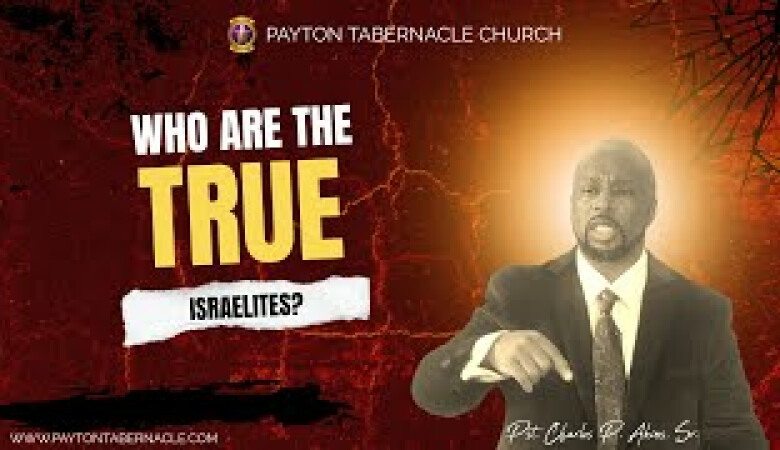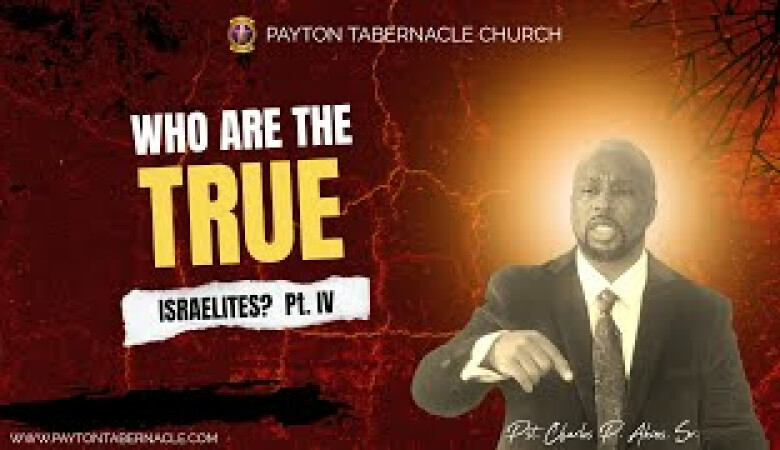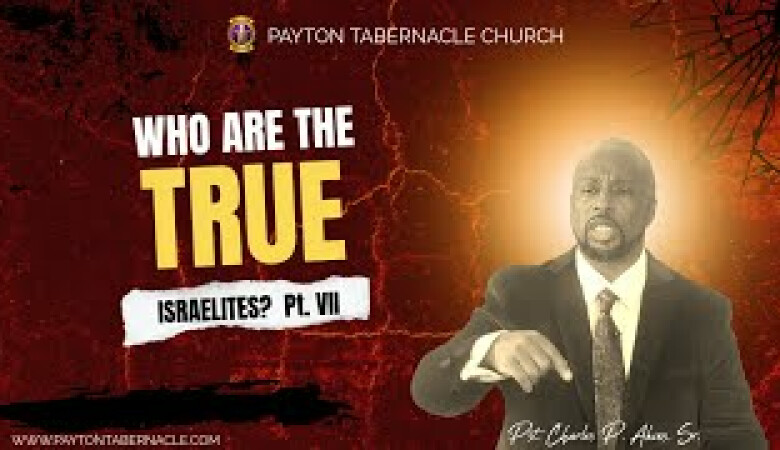Series: Who Are the True Israelites?
"Egyptology The Coverup!" Part III
October 26, 2025 | Pastor Charles P. Akins, Sr.
Passage: Genesis 42:7-8
Lesson #3
Text: Gen 42:7-8, Ex 2:13-14, 11:2-3, Mat 2:13-15
Title: “Egyptology the Cover Up!”
What We have learned, thus far:
• African Americans/Negroes aren’t Ham’s Descendants as we are taught
• Negroes are actually Semitic People or descendants of Shem (Zondervan Biblical Dictionary)
• Canaanites were originally descendants of Canaan, son of Ham and occupied the Levant
• Mesopotamia had a Cushitic King (Son of Cush) named Nimrod
• Semitic refers to languages, not to a racial category
The reason for changing names then lies in the medical, scientific, agricultural, and mathematical knowledge these people received being taught in Africa.
Once these people were finally, after many defeats, able to conquer parts of Africa, they wanted to lay claim to the intellectual property and prowess of the original people by wiping all traces of them out of the supposed “history”
3. Egyptians are African & they resembled Israelites:
Again, Egypt is not the ancient/original name of that land.
It is a name created during the archaic Greek era, whose exact origin is in debate.
Mizrahim: is the Hebrew/Aramaic name for Egypt
Definition: burnt face or black
Kemet: is the Ancient name given by the original peoples of the land.
Definition: land of the blacks meaning egypt and all of africa. The land where the original people (black people) started their civilizations.
Notice that both original peoples agree that it is the land of dark people.
Ham: (Mizraim’s Father) name means hot or dark
Kemet and Ham have the same definition in Hebrew, which refers to the complexion of the people.
Mizraim, who is the son of Ham, the Father to all Africans/Alkebulans, settled in Kemet, while Cush settled in Cush, now known as Ethiopia.
What motivated Greeks, Romans, and others who deny their actual history, migration/invasions which led to changing the name of a continent and country, as well as the historical look/race of its original people?
Hiding the original names, hides the historical identity of the true inhabitants of the lands. When you are the one teaching the history you can teach what you like.
Once this occurs, you can tell whatever “stories” you like and call them history. "History belongs to he who writes it!"
In "The Odyssey", Homer used “Aegyptus” to refer to the land of Egypt, meaning it was in use by the eighth century B.C. Victorian sources suggested "Aegyptus" a corruption of Hwt-ka-Ptah (Ha-ka-Ptah), “home of the soul of Ptah.” That was the Egyptian name for the city of Memphis, where Ptah, the potter-creator god, was chief deity. But there was a fellow named Aegyptus who plays a big role here, too.
According to Pseudo-Apollodorus in his Library, a line of mythological Greek kings ruled over northern Africa. That false statement gave his people a right to "claim" another region's rich history. Epaphus, son of Zeus and Io, the woman-turned-cow, “married Memphis, daughter of Nile, founded and named the city of Memphis after her, and begat a daughter Libya, after whom the region of Libya was called.” Thus, huge swathes of Africa owed their names and livelihoods to the Greeks, or so they said.
As you see, It wasn’t uncommon for some people to make things up and refer to them facts, or use them as justifications for their actions/self-promotion.
Descended from this family was another name-inducing man: Aegyptus, who “subjugated the country of the Melampodes and named it Egypt.” Whether or not the original text of the Library stated he named it after himself is up for debate. In Greek, “Melampodes” means “black feet,” (which I believe more than likely referenced the feet of the original people, rather than the soil they walked on, which the writer claims) perhaps because they walked in the rich dark soil of their land, which the annual Nile inundation/flood brought up from the river floor. But the Greeks were far from the first people to notice the black soil of the Land of the Nile. (Wikipedia)
At the 1974 UNESCO Symposium in Cairo, Cheikh Anta Diop and Theophile Obenga presented their findings to an international audience of scholars and experts. Their presentations were groundbreaking because they provided evidence that directly contradicted the Eurocentric view of ancient Egypt. Diop’s presentation focused on the physical anthropology of ancient Egyptians and demonstrated that they were of African descent. He argued that the ancient Egyptians were part of a broader Black African civilization that included other cultures, such as the Nubians, the Ethiopians, and the people of the Congo.
Obenga’s presentation focused on the Meroitic script and demonstrated that it was a direct ancestor of the hieroglyphic script used by the ancient Egyptians. The Meroitic script consists of two alpha syllabic scripts developed to write the Meroitic language at the beginning of the Meroitic Period of the Kingdom of Kush. The two scripts are Meroitic Cursive, derived from Demotic Egyptian, and Meroitic Hieroglyphs, derived from Egyptian hieroglyphs. He argued that the Meroitic script was not a “dead” language but rather a living language that was still spoken by the people of Sudan. Obenga’s presentation also challenged the Eurocentric view that the hieroglyphic script had been “invented” by the ancient Greeks or Phoenicians and that the ancient Egyptians had no real connection to the script.
Together, Diop and Obenga’s presentations provided compelling evidence that ancient Egypt was a Black African civilization and that the Meroitic script was a direct ancestor of the hieroglyphic script. Their work challenged the dominant narrative that had been established by European scholars and demonstrated the importance of African scholarship in the study of ancient history.
All of this demonstrates the impossibility of the authenticity of the present-day people occupying these nations such as Egypt. Rather they are merely colonizers and not the original people of the lands.
Note: Skin Cancer rates in Israel are of the highest in the world, second only to Australia.
Now let us recall some true facts of Israeli history:
• Joseph was not recognizable, as an Israeli, to his brothers, which means he blended in with the Egyptians he now lived with. (1700 BCE During Hyksos Dynasty)
• Moses was not distinguishable from an Egyptian the entire time he lived in the Egyptian Palace. (1500 BCE Original People of Kemet rule again)
• Joseph and Mary hid in Egypt during the time of the census after learning what Herod was planning. (You can’t hide without blending in)
Joseph, who was a Semite/Israelite, is believed to have been captive and rule in Egypt during the periods of 1700-1500 BCE and to have lived approximately 120 yrs. He would have arrived during the Hyksos rule of Egypt.
Since Hyksos were Afro-Asiatic that would make them Ethiopian, or original people of the Ethiopian lands (Dark Complexion).
Moses is said to have been born in the 1500 BCE period when the Hyksos were defeated. This is the point where Egypt’s Leadership, again, changes hands and was now ruled by its original people again, which explains Rameses II distaste for those identified as Israelites. They are the reminder of foreign rule in the country.
Nonetheless, these peoples represented the original peoples of the Mesopotamia areas, which were of darker complexion.
The people indigenous to these areas are not the people who inhabit them today.
Much like the Moors, these peoples were the founding fathers of the regions, and not immigrants who stole the land and begin to claim it as their heritage.
Despite the fact that it lacks official status, Egyptian Arabic (Babbel, a spoken variant of the macrolanguage) is actually the most commonly spoken language in Egypt and is considered the de facto national language. Its current form is a mixture of Arabic, Coptic, Turkish, Ottoman, French and Italian influences.
As seen by the definition above True Arabic was Afro-Asiatic in origin as well, and the invasion, and subsequent colonization of Egypt/Kemet, and the rest of Middle East African territories as well, is what changed the language, as well as the complexion of all peoples in those areas.
Ancient Egyptian was an Afro-Asiatic language. Thus, proving that Egyptians, true and original Egyptians were, in fact, Ethiopian/African people.
Egyptians were Afrocentric from the start, as is noted by all original Hieroglyphics, and the fact that for 25 dynasties Egypt was not under non-Ethiopian/African rule. As a result, those who invaded during the period in question were Ethiopian/African also.
4. Semitic/Afro-Asiatic and Egyptian peoples looked alike:
What we see from this is that the Egyptians were of a Dark complexion, as were the invading Hyksos Semitics, who clearly happened to resemble Egyptians.
It is also important to point out that all these groups were Semitic in the Northern and Middle Eastern Ethiopian/African areas.
Semitic:
• relating to or denoting a family of languages that includes Hebrew, Arabic, and Aramaic and certain ancient languages such as Phoenician and Akkadian, constituting the main subgroup of the Afro-Asiatic family.
• relating to the peoples who speak Semitic languages, especially Hebrew and Arabic.
For this reason, neither Joseph nor Moses was distinguishable from the Egyptians in power at the time. (Be it Kemetian or Hyksos Rulers)
It could be said that part of the issue with the slavery of Israel stemmed from them being part of the Hyksos (Invaders) Governments rule.
It’s time that some people stopped trying to delegitimize their own migratory patterns and activities in the hopes of lying about their origin and the lands they colonized.






